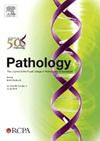Are deeper sections and immunohistochemistry useful in detecting micrometastases and isolated tumour cells in colorectal cancer?
IF 3
3区 医学
Q1 PATHOLOGY
引用次数: 0
Abstract
Identification of lymph node metastases is critical for staging of colorectal cancer. Lymph node metastases are classified based on size as macrometastases, micrometastases, or isolated tumour cells (ITCs). Micrometastases are associated with worse prognosis; however, optimal detection methods have yet to be established. The first objective was to determine if deeper levels and immunohistochemistry would detect micrometastases in patients with metastatic disease but negative lymph nodes. Five patients with pT3N0 colorectal adenocarcinoma who developed metastatic disease were identified. Three deeper haematoxylin and eosin (H&E) levels followed by pan-cytokeratin immunohistochemistry was performed on all lymph nodes. No micrometastases were detected; however, ITCs were seen by immunohistochemistry in three of five patients. Driven by these findings, the second objective was to determine if a single level stained for pan-cytokeratin would identify ITCs and if their presence was associated with an increased risk of disease recurrence. A cohort of eight patients with stage IIA (pT3N0M0) colorectal adenocarcinoma who developed distant metastasis was matched to eight control patients who remained disease-free over a 5-year period, and a single pan-cytokeratin stain was performed on all lymph nodes. ITCs were identified in six of eight patients that developed metastasis and in five of eight control patients (odds ratio=1.80; 95% confidence interval=0.21–15.41). In conclusion, three deeper levels and immunohistochemistry did not increase the yield of micrometastases in pT3N0 colorectal adenocarcinoma. While ITCs were readily identified by immunohistochemistry, their presence was not a significant predictor of distant recurrence. These findings do not support the routine use of deeper levels and immunohistochemistry for lymph node staging.
深层切片和免疫组织化学对检测结直肠癌的微转移和分离肿瘤细胞有用吗?
淋巴结转移的识别对结直肠癌的分期至关重要。淋巴结转移根据大小分为大转移、微转移或分离的肿瘤细胞(ITCs)。微转移与较差的预后相关;然而,最佳的检测方法尚未建立。第一个目的是确定更深层次和免疫组织化学是否可以检测转移性疾病但淋巴结阴性的患者的微转移。5例pT3N0结直肠腺癌患者发生转移性疾病。在所有淋巴结进行三次更深的血红素和伊红(H&E)水平,然后进行泛细胞角蛋白免疫组化。未发现微转移;然而,免疫组织化学在5例患者中有3例可见ITCs。在这些发现的推动下,第二个目标是确定单水平泛细胞角蛋白染色是否可以识别ITCs,以及它们的存在是否与疾病复发风险增加有关。8名发生远处转移的IIA期(pT3N0M0)结直肠癌患者与8名5年内无疾病的对照患者进行配对,并对所有淋巴结进行单一泛细胞角蛋白染色。8例发生转移的患者中有6例发现了ITCs, 8例对照患者中有5例发现了ITCs(优势比=1.80;95%置信区间=0.21-15.41)。综上所述,三个更深层次和免疫组化并没有增加pT3N0结直肠腺癌的微转移率。虽然ITCs很容易通过免疫组织化学识别,但它们的存在并不是远处复发的重要预测因子。这些发现不支持常规使用更深层次和免疫组织化学进行淋巴结分期。
本文章由计算机程序翻译,如有差异,请以英文原文为准。
求助全文
约1分钟内获得全文
求助全文
来源期刊

Pathology
医学-病理学
CiteScore
6.50
自引率
2.20%
发文量
459
审稿时长
54 days
期刊介绍:
Published by Elsevier from 2016
Pathology is the official journal of the Royal College of Pathologists of Australasia (RCPA). It is committed to publishing peer-reviewed, original articles related to the science of pathology in its broadest sense, including anatomical pathology, chemical pathology and biochemistry, cytopathology, experimental pathology, forensic pathology and morbid anatomy, genetics, haematology, immunology and immunopathology, microbiology and molecular pathology.
 求助内容:
求助内容: 应助结果提醒方式:
应助结果提醒方式:


